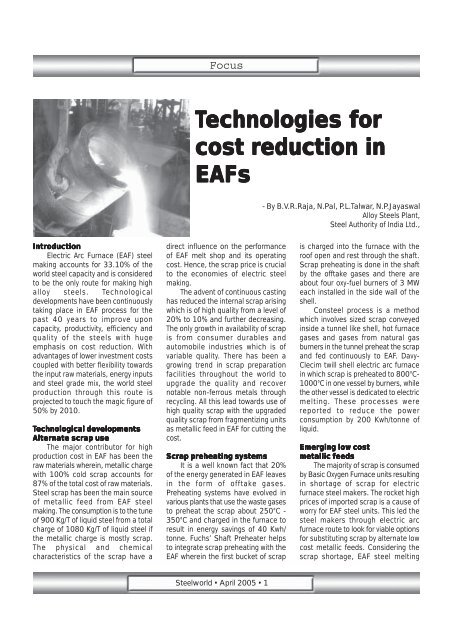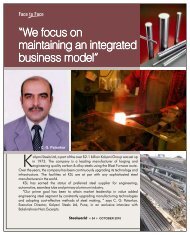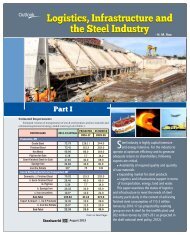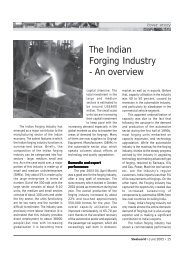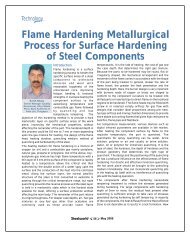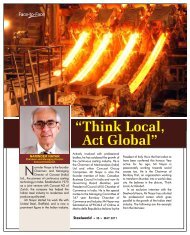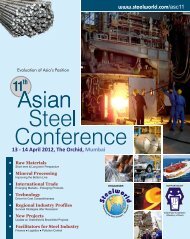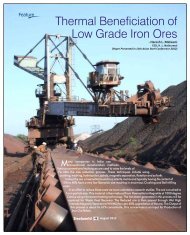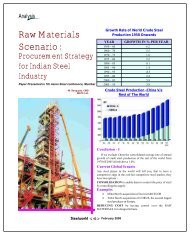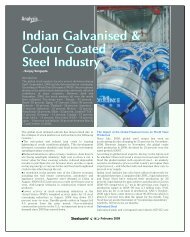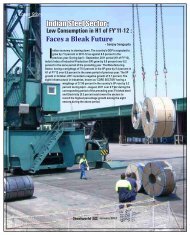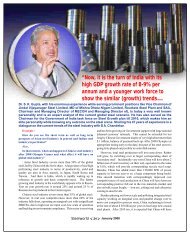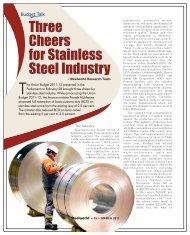Technologies for cost reduction in EAFs - Steelworld
Technologies for cost reduction in EAFs - Steelworld
Technologies for cost reduction in EAFs - Steelworld
You also want an ePaper? Increase the reach of your titles
YUMPU automatically turns print PDFs into web optimized ePapers that Google loves.
F o c u s<strong>Technologies</strong> <strong>for</strong><strong>cost</strong> <strong>reduction</strong> <strong>in</strong><strong>EAFs</strong>- By B.V.R.Raja, N.Pal, P.L.Talwar, N.P.JayaswalAlloy Steels Plant,Steel Authority of India Ltd.,IntroductionElectric Arc Furnace (EAF) steelmak<strong>in</strong>g accounts <strong>for</strong> 33.10% of theworld steel capacity and is consideredto be the only route <strong>for</strong> mak<strong>in</strong>g highalloy steels. Technologicaldevelopments have been cont<strong>in</strong>uouslytak<strong>in</strong>g place <strong>in</strong> EAF process <strong>for</strong> thepast 40 years to improve uponcapacity, productivity, efficiency andquality of the steels with hugeemphasis on <strong>cost</strong> <strong>reduction</strong>. Withadvantages of lower <strong>in</strong>vestment <strong>cost</strong>scoupled with better flexibility towardsthe <strong>in</strong>put raw materials, energy <strong>in</strong>putsand steel grade mix, the world steelproduction through this route isprojected to touch the magic figure of50% by 2010.Technological developmentsAlternate scrap useThe major contributor <strong>for</strong> highproduction <strong>cost</strong> <strong>in</strong> EAF has been theraw materials where<strong>in</strong>, metallic chargewith 100% cold scrap accounts <strong>for</strong>87% of the total <strong>cost</strong> of raw materials.Steel scrap has been the ma<strong>in</strong> sourceof metallic feed from EAF steelmak<strong>in</strong>g. The consumption is to the tuneof 900 Kg/T of liquid steel from a totalcharge of 1080 Kg/T of liquid steel ifthe metallic charge is mostly scrap.The physical and chemicalcharacteristics of the scrap have adirect <strong>in</strong>fluence on the per<strong>for</strong>manceof EAF melt shop and its operat<strong>in</strong>g<strong>cost</strong>. Hence, the scrap price is crucialto the economies of electric steelmak<strong>in</strong>g.The advent of cont<strong>in</strong>uous cast<strong>in</strong>ghas reduced the <strong>in</strong>ternal scrap aris<strong>in</strong>gwhich is of high quality from a level of20% to 10% and further decreas<strong>in</strong>g.The only growth <strong>in</strong> availability of scrapis from consumer durables andautomobile <strong>in</strong>dustries which is ofvariable quality. There has been agrow<strong>in</strong>g trend <strong>in</strong> scrap preparationfacilities throughout the world toupgrade the quality and recovernotable non-ferrous metals throughrecycl<strong>in</strong>g. All this lead towards use ofhigh quality scrap with the upgradedquality scrap from fragmentiz<strong>in</strong>g unitsas metallic feed <strong>in</strong> EAF <strong>for</strong> cutt<strong>in</strong>g the<strong>cost</strong>.Scrap preheat<strong>in</strong>g systemsIt is a well known fact that 20%of the energy generated <strong>in</strong> EAF leaves<strong>in</strong> the <strong>for</strong>m of offtake gases.Preheat<strong>in</strong>g systems have evolved <strong>in</strong>various plants that use the waste gasesto preheat the scrap about 250°C -350°C and charged <strong>in</strong> the furnace toresult <strong>in</strong> energy sav<strong>in</strong>gs of 40 Kwh/tonne. Fuchs’ Shaft Preheater helpsto <strong>in</strong>tegrate scrap preheat<strong>in</strong>g with theEAF where<strong>in</strong> the first bucket of scrapis charged <strong>in</strong>to the furnace with theroof open and rest through the shaft.Scrap preheat<strong>in</strong>g is done <strong>in</strong> the shaftby the offtake gases and there areabout four oxy-fuel burners of 3 MWeach <strong>in</strong>stalled <strong>in</strong> the side wall of theshell.Consteel process is a methodwhich <strong>in</strong>volves sized scrap conveyed<strong>in</strong>side a tunnel like shell, hot furnacegases and gases from natural gasburners <strong>in</strong> the tunnel preheat the scrapand fed cont<strong>in</strong>uously to EAF. Davy-Clecim twill shell electric arc furnace<strong>in</strong> which scrap is preheated to 800°C-1000°C <strong>in</strong> one vessel by burners, whilethe other vessel is dedicated to electricmelt<strong>in</strong>g. These processes werereported to reduce the powerconsumption by 200 Kwh/tonne ofliquid.Emerg<strong>in</strong>g low <strong>cost</strong>metallic feedsThe majority of scrap is consumedby Basic Oxygen Furnace units result<strong>in</strong>g<strong>in</strong> shortage of scrap <strong>for</strong> electricfurnace steel makers. The rocket highprices of imported scrap is a cause ofworry <strong>for</strong> EAF steel units. This led thesteel makers through electric arcfurnace route to look <strong>for</strong> viable options<strong>for</strong> substitut<strong>in</strong>g scrap by alternate low<strong>cost</strong> metallic feeds. Consider<strong>in</strong>g thescrap shortage, EAF steel melt<strong>in</strong>g<strong>Steelworld</strong> • April 2005 • 1
F o c u sshops are consider<strong>in</strong>g usage ofmetallic feeds like Sponge Iron and HotMetal <strong>for</strong> reduc<strong>in</strong>g the production <strong>cost</strong>.Sponge iron ( DRI/HBI )The evolution of sponge iron asmetallic feed <strong>in</strong> EAF has been ma<strong>in</strong>lydue to its <strong>cost</strong> advantage over scrap.It is a high quality metallic productproduced from iron ore/pellets and canbe used as a suitable feed stock aspartial substitution to scrap <strong>in</strong> EAF. Itoffers benefits like guaranteed uni<strong>for</strong>mand predictable compositionconta<strong>in</strong><strong>in</strong>g low amounts of sulphur,phosphorous & tramp elements alongwith environmental friendl<strong>in</strong>ess dur<strong>in</strong>gusage. The typical composition ofsponge iron is shown <strong>in</strong> Table 1.Coal based sponge iron hascarbon content of 0.25% andmetallization of 90% while gas basedsponge iron has carbon of 1.6% andmetallization to the tune of93%.Sponge iron has bulk density of2 – 3.3. t/cu.m. and is higher thanthat of most scrap. The actual densityis more than that of slag <strong>in</strong> thefurnace to facilitate sponge ironmelt<strong>in</strong>g at the slag/metal <strong>in</strong>terface.When sponge iron is used, thereis a need to reduce the iron oxide andto neutralize the acid gangue. The<strong>reduction</strong> of 1% iron oxide requiresapprox. 2.3 Kg of carbon and 12 Kwh/ton of liquid steel. The neutralizationof acid gangue (Al 2O 3+ SiO 2) requires20 Kg of lime and power to the tuneof 11 Kwh/tonne of liquid steel toachieve required slag basicity.Cont<strong>in</strong>uous charg<strong>in</strong>g is the widelypracticed method where<strong>in</strong> charg<strong>in</strong>gstarts after creation of partial moltenpool <strong>in</strong> the bath and is cont<strong>in</strong>uedthrough the charge b<strong>in</strong>s provided alongthe roof. This charg<strong>in</strong>g system enablesbetter distribution of charge withimproved bath heat transfer and slagmetalmix<strong>in</strong>g. It lowers heat losses andhelp <strong>in</strong> produc<strong>in</strong>g stable arc withimproved productivity and up to 80%DRI <strong>in</strong> the charge can be successfullyfed through this method.The optimum benefits aregenerally believed to be atta<strong>in</strong>ed whenthe melt<strong>in</strong>g of DRI takes place at theslag/metal <strong>in</strong>terface whichnecessitates appropriate feed rate.The feed rate further is dependent onthe chemical composition of DRI andthe bath temperature. Generally, feedrates of 27 to 35 Kg/m<strong>in</strong>./MW ofapplied power are ma<strong>in</strong>ta<strong>in</strong>ed.However, higher the metallizationTOTAL Fe 87% - 94% P 0.007% - 0.05%METALLIC Fe 76% - 89% SiO2 2% - 4%METALLIZATION 86% - 93% Al2O3 0.60% - 2.7%C 0.20% - 2.4% CaO + MgO 0.2% - 3%S 0.01% - 0.03%Table 1 - Typical composition of sponge iron(optimimumrequired levelis 93%),lower isthe powerconsumptionand higher yield which necessitatescarbon <strong>in</strong>jection systems to take careof metallization problems. It has beenobserved that <strong>for</strong> every 1% decrease<strong>in</strong> metallization, the <strong>in</strong>crease <strong>in</strong> powerconsumption is to the tune of 18 Kwh/ton. Productivity about 1 ton per houris reported <strong>for</strong> every 10% <strong>in</strong>crease <strong>in</strong>DRI usage.There has been a new trend <strong>in</strong>cont<strong>in</strong>uous feed<strong>in</strong>g of hot DRI withtemperatures of 500ºC - 600ºC <strong>for</strong>the units which has accessibility to DRIfurnace. Introduc<strong>in</strong>g hot DRI surge b<strong>in</strong>between the DRI furnace and EAF, upto 80% DRI <strong>in</strong> the charge issuccessfully fed. With hot DRIcharg<strong>in</strong>g, the effect of metallization iscompensated by the temperature ofDRI itself thus possess<strong>in</strong>g highpotential <strong>in</strong> sav<strong>in</strong>g energy. Thispractice can reduce powerconsumption by 20 Kwh/T of liquidsteel <strong>for</strong> each 100ºC <strong>in</strong>crease <strong>in</strong>composite charge temperature. Energysav<strong>in</strong>gs of 105 Kwh/t <strong>for</strong> 80% DRIcharge compared to 52 Kwh/t <strong>for</strong> 40%DRI charg<strong>in</strong>g have been reported.Electrode consumption gets reducedby 30% when cont<strong>in</strong>uous feed<strong>in</strong>g ofDRI as it produces stable steel bathreduc<strong>in</strong>g the possibility of electrodebreakage , compared to theconventional 100% cold scrap chargepractice. This is due to higherproductivity, decreased electrodeoxidation, less frequency of roofopen<strong>in</strong>g mean<strong>in</strong>g less thermal shock,less CO <strong>in</strong> furnace atmosphere andless electrode breakages.Hot metal (Liquid Pig Iron)This is a low <strong>cost</strong> metallic feed<strong>for</strong> <strong>EAFs</strong> which have access to blastfurnace or cupola. The typicalcomposition of hot metal is shown <strong>in</strong>Table 2.C Mn Si P S3.75% 0.48% 0.85% 0.18% 0.035%Table 2 - Typical composition of hot metalThe sensible heat of molten pigiron at the melt<strong>in</strong>g po<strong>in</strong>t is around1084 MJ/mg. Assum<strong>in</strong>g the heatefficiency of EAF at 80%, this heat willbe equivalent to about 1350 MJ/mg(375 Kwh/Ton) of liquid pig iron. It isestimated that 1 Ton Hot Metal + 25Kg Lime = 0.92 Ton of clear scrap +40 Kg of carbon + 330 Kwh. To derivemaximum benefit from the addition ofliquid pig iron, it is necessary to lookat parameters like the composition ofthe charge mix, thermal condition ofthe charge at the time of hot metaladdition and proper melt<strong>in</strong>g practiceto take care of high phosphorous andcarbon.Hot metal is added <strong>in</strong> EAF throughspout ladles after roof open<strong>in</strong>g. It isadded after partial melt <strong>for</strong>mation <strong>in</strong>EAF. If hot metal addition is carried outto a full melted over oxidized steel bath<strong>in</strong> EAF, reactions occur lead<strong>in</strong>g toviolent boil<strong>in</strong>g. Hot liquid metal ifadded soon after power on, <strong>in</strong> contactwith cold scrap immediately freezes2 • <strong>Steelworld</strong> • April 2005
F o c u sdue to chill<strong>in</strong>g effect. Hence, additionof liquid metal on sufficiently heatedscrap seems to be the most efficientcharg<strong>in</strong>g practice. This is because, asthe scrap gradually melts, the alreadyliquid pig iron gets ref<strong>in</strong>ed under theaction of iron ore and lime <strong>in</strong> thecharge.The amount of hot metal to becharged depends on the grade of steelto be made and the amount of oxygendeemed efficient. Successful hotmetal practices reveal usage to theextent of 60% of the total charge. Themajor problem with hot metal isdephosphorization of the melt <strong>in</strong> EAF.This is taken care through addition ofsufficient amount of iron ore <strong>in</strong> thecharge that facilitates high FeO (15%- 20% ) and 75% dephosphorizationbe<strong>for</strong>e oxygen blow at melt down stage.Carbon is removed by iron ore partiallyand the required level of carbonachieved through oxygen <strong>in</strong>jection athigh rates. It is noticed that hot metalposes no problem with regard to qualityrequirements of carbon and low alloysteels. Energy sav<strong>in</strong>gs of 130 Kwh/T,<strong>in</strong>crease <strong>in</strong> productivity by 25% andreduced electrode consumption by15% are achieved through use of 60%hot metal <strong>in</strong> the charge.Hot metal + Sponge ironThe new trend <strong>for</strong> <strong>cost</strong> effectiveproduction processes <strong>in</strong> EAF iscomb<strong>in</strong>ed use of hot metal and coalbased sponge iron by completelysubstitut<strong>in</strong>g scrap. With hot metalusage, <strong>in</strong>itial slag of EAF has low FeOcontent unless sufficient amount ofiron ore is charged which makes theslag viscous lead<strong>in</strong>g to poorphosphorous removal and poor arcefficiency caused by non-foam<strong>in</strong>ess ofthe slag. Due to high carbon <strong>in</strong> hotmetal, the decarburization raterequirement is as high as 0.25% C/m<strong>in</strong> which limits its usage <strong>in</strong> EAF dueto low depth/volume ratio. Bycont<strong>in</strong>uous feed<strong>in</strong>g of coal based DRI,dephosphorization becomes fasterand FeO of DRI promotes foamy slagpromot<strong>in</strong>g decarburization thusreduc<strong>in</strong>g oxygen blow<strong>in</strong>g time. Even,<strong>in</strong>crease <strong>in</strong> yield to the tune of 2%achieved compared to 80% DRImethod.The various practices followed areusage of hot metal between 40% to60% and the rema<strong>in</strong><strong>in</strong>g with DRI.Productivity improvement by 50%,energy sav<strong>in</strong>gs of 200 Kwh/T andelectrode consumption <strong>reduction</strong> by40% have been reported through thismethod.Low ow <strong>cost</strong> energy <strong>in</strong>putsAs energy accounts <strong>for</strong> around12% of the production <strong>cost</strong>, there isan <strong>in</strong>creas<strong>in</strong>g trend <strong>in</strong> application ofoxygen as chemical energy <strong>in</strong>put <strong>for</strong>reduc<strong>in</strong>g energy consumption. Today,oxygen to the tune of 30 Nm 3 /t is be<strong>in</strong>gused <strong>in</strong> many EAF units <strong>in</strong> the world toreduce melt<strong>in</strong>g time & powerconsumption coupled with recovery ofenergy through CO post combustion.Moveable oxygen <strong>in</strong>jection systems likesubmersible hand lance, consumablepipe manipulators, water cooled lancesor retractable burners and fixed oxygen<strong>in</strong>troduction systems like oxy-fuelburners, supersonic jet burners, carbon<strong>in</strong>jection lance with oxygen and virtuallance burners are widely used. Sav<strong>in</strong>gs<strong>in</strong> energy is about 3 Kwh/Nm 3 oxygenper ton of liquid steel when one kg ofcoke is added <strong>in</strong> EAF. Evolution ofthese technologies helped to meet10% energy requirements andproductivity improvement of around8%.Ultra high powered furnacesIt is a well known fact that higherthe rate of power <strong>in</strong>put, higher thethermal efficiency due to <strong>reduction</strong> <strong>in</strong>time dependant heat losses. Thisresulted <strong>in</strong> development of Ultra HighPowered EAF units with rat<strong>in</strong>g of morethan 700 KVA per ton. However, higherrate of power <strong>in</strong>creases arc currentwhich would <strong>in</strong>crease electrode tiperosion. Hence, with higher power<strong>in</strong>put, the applied voltage has to bemore which can be achieved throughuse of longer arcs. These longer arcsled to high refractory erosion. To takecare of this problem, water cooledpanels were developed to replacemuch of the furnace side wall and roofrefractory. Though the application ofpanels drastically reduced therefractory consumption, the heatlosses <strong>in</strong>creased which made <strong>EAFs</strong>teel makers to splash molten slag <strong>for</strong>improv<strong>in</strong>g thermal efficiency. Otherdevelopments that took place tocounter the long arc operation <strong>in</strong>cludefoamy slag practice. In this practice,carbon and oxygen are <strong>in</strong>jected <strong>in</strong> bath<strong>in</strong>creas<strong>in</strong>g the slag cover depth from0.1 m – 1.0 m act<strong>in</strong>g as additionalenergy bury<strong>in</strong>g the arc and improv<strong>in</strong>gthermal efficiency. The process led topower sav<strong>in</strong>gs to the tune of 40 Kwh/T along with better slag deoxidation.Bath stirr<strong>in</strong>gThis development helped toabsorb the high power <strong>in</strong>puts presently<strong>in</strong> use coupled with sav<strong>in</strong>gs <strong>in</strong> yield tothe tune of 5 Kg/T and energy about14 Kwh/T. Also, bath stirr<strong>in</strong>g resulted<strong>in</strong> produc<strong>in</strong>g slag with low FeO & MnO<strong>Steelworld</strong> • April 2005 • 3
F o c u scontents decreas<strong>in</strong>g alum<strong>in</strong>umconsumption.Slag free tapp<strong>in</strong>g systemsSlag free tapp<strong>in</strong>g technologiesevolved <strong>for</strong> improvement <strong>in</strong> steelquality and also productivity throughlow temperature tapp<strong>in</strong>g and shortertap duration. Eccentric Bottom Tapp<strong>in</strong>gprocess is the one where the bottomhalf of the furnace is fitted witheccentrically located tap hole bywiden<strong>in</strong>g the tapp<strong>in</strong>g area andremov<strong>in</strong>g the conventional spout.Submerged Tap Hole method is amodification to the conventional taphole with the tap hole spout extend<strong>in</strong>gthe hearth profile allow<strong>in</strong>g steel tapp<strong>in</strong>gwithout vortex<strong>in</strong>g. Though, this processis cheaper and efficient, the tapp<strong>in</strong>gtimes and temperature losses are <strong>in</strong>excess compared to other techniques.Slide gate Tapp<strong>in</strong>g technique is ahydraulically operated l<strong>in</strong>ear slid<strong>in</strong>ggate valve mounted on the outlet taphole of the furnace. Here, the slidegate rema<strong>in</strong>s <strong>in</strong> open mode throughoutthe melt<strong>in</strong>g period and the tap hole isfilled with filler material by use ofpusher rod with the filler materialremoved prior to tapp<strong>in</strong>g by scoopdevice or by mild oxygen lanc<strong>in</strong>g. In thistechnique, the gate valve is closedonce slag just starts com<strong>in</strong>g <strong>in</strong>. Thebenefits accrued through thesesystems <strong>in</strong>clude production of low “P”steels, extra low “S” steels, decrease<strong>in</strong> treatment time of secondary ref<strong>in</strong><strong>in</strong>gunits and reduced alum<strong>in</strong>umconsumption.Automation systemsComputer assisted steel mak<strong>in</strong>ghas evolved through development ofsensors and programm<strong>in</strong>g of power<strong>in</strong>put, charg<strong>in</strong>g practice, amount ofoxygen lanc<strong>in</strong>g and adjustments ofchemistry dur<strong>in</strong>g melt<strong>in</strong>g & ref<strong>in</strong><strong>in</strong>g.Process control equations throughprogramm<strong>in</strong>g are applied <strong>for</strong> assess<strong>in</strong>gthe overall furnace per<strong>for</strong>mance as wellas calculat<strong>in</strong>g requisite amounts ofoxygen and power <strong>in</strong>put <strong>for</strong> achiev<strong>in</strong>gthe desired tapp<strong>in</strong>g conditions <strong>for</strong>carbon and temperature. Least CostMix programmes are developed withprocess <strong>cost</strong> elements like yield, timeand energy as a means to cut down<strong>cost</strong>s.ConclusionsCont<strong>in</strong>uous developments hasreshaped EAF steel mak<strong>in</strong>g process tomeet the steel requirements of theworld. Modifications are still on <strong>in</strong> EAFto br<strong>in</strong>g <strong>in</strong> further improvements <strong>in</strong>productivity, energy economy,application of cheaper metallic feeds,reduced electrode & refractoryconsumption to make EAF as thelowest <strong>cost</strong> steel produc<strong>in</strong>g route <strong>in</strong>the world. !!!4 • <strong>Steelworld</strong> • April 2005


